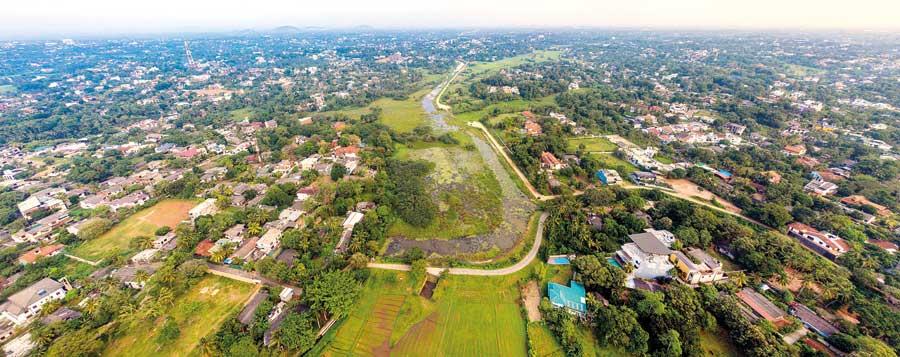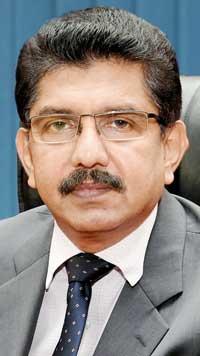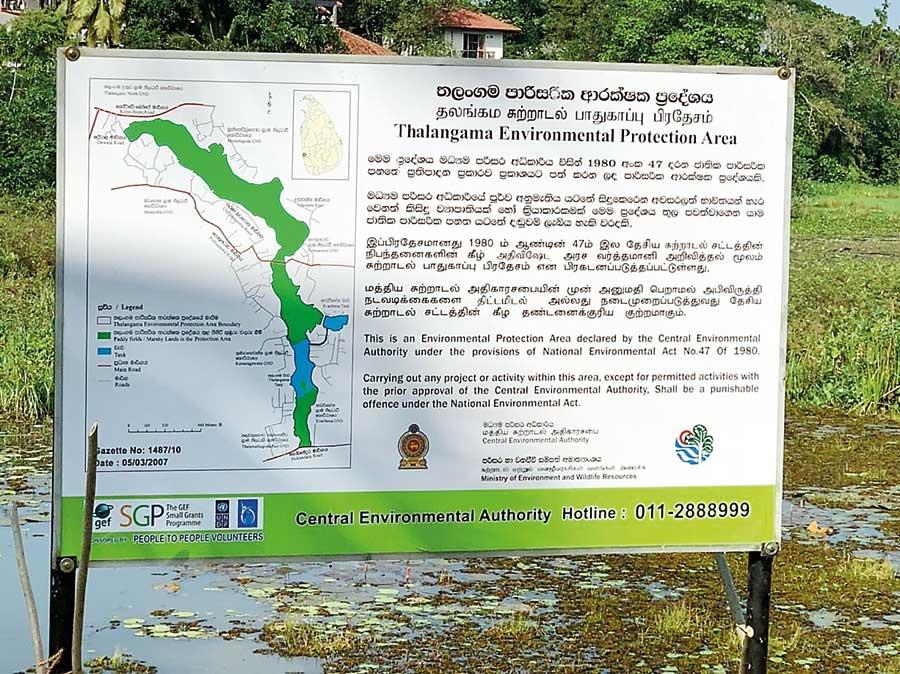30 Jul 2021 - {{hitsCtrl.values.hits}}
Elevated expressway via Thalangama Wetland permitted

- Development projects in urban wetlands could pose flood threat to Colombo
- United Nations has been urged to intervene and save these unique ecosystems in the country
Amidst strong protests to protect the environmentally sensitive Thalangama Environmental Protection Area, the authorities have taken a bold (or rather ignorant) step to include the construction of the Four Lane Elevated Highway from New Kelani Bridge to Athurugiriya via the gazetted Protected Area. The importance of wetlands has been highlighted in many instances and disrupting these ecosystems would give rise to floods and other natural disasters. The Protected Area has recently been re-gazetted when a writ petition is pending in courts. Following the re-gazetting a motion has been filed to take up the case immediately but residents fear that Colombo will soon lose one of its last remaining green patches.
authorities have taken a bold (or rather ignorant) step to include the construction of the Four Lane Elevated Highway from New Kelani Bridge to Athurugiriya via the gazetted Protected Area. The importance of wetlands has been highlighted in many instances and disrupting these ecosystems would give rise to floods and other natural disasters. The Protected Area has recently been re-gazetted when a writ petition is pending in courts. Following the re-gazetting a motion has been filed to take up the case immediately but residents fear that Colombo will soon lose one of its last remaining green patches.
Highway construction now a permitted activity
As per gazette notification No. 2237/7 published on July 19, 2021 an amendment has been made to Schedule II of Gazette Extraordinary No. 1487/10 of March 5, 2007 by adding the ‘construction, operation and maintenance of a four-lane Elevated Highway from New Kelani Bridge to Athurugiriya’ as a permitted activity. When the limits of the Thalangama Environmental Protection Area was gazetted in 2007 the only permitted activities as per Schedule II were cultivation of paddy, nature trails, construction of towers for the observation of birds, construction of a security post and an environmental education information Centre and a sales outlet. Schedule III of the Gazette further elaborated the conditions in which these permitted activities should be carried out such as restricting fishing activities to traditional fishing methods without using motors and it is very clear that the gazette has given more prominence to the sustainability of the environment. Even though the new amendment further mentions that the construction of a four lane elevated highway will not have adverse impacts on the Environmental Protection Area, environmentalists have reasonable doubts as to how this could be achieved without conducting an Environmental Impact Assessment.
"A development activity cannot be done in a gazetted area unless it’s included in the gazette. Therefore we included the construction of the four lane elevated highway as a permitted activity.
- CEA Chairman Siripala Amarasinghe"
Permitted but not approved
The Central Environmental Authority (CEA) is the apex body vested with powers to enforce legislation and protect the environment. When the Dailymirror reported on the new developments pertaining to the matter in June, this paper was told that the Gazette was pending at the Legal Draftsman’s Department. The CEA affirmed that an EIA would be done once the Legal Draftsman revert the gazette with his observations. A month or so later, the Thalangama Environmental Protection Area is re-gazetted with a new permitted activity sans an EIA.
“A development activity cannot be done in a gazetted area unless it’s included in the gazette. Therefore we included the construction of the four lane elevated highway as a permitted activity,” opined CEA Chairman Siripala Amarasinghe. “But approval to construct the bridge is only until the Rajagiriya exit. So far no Initial Environmental Assessment or EIA has been done along the stretch from a Rajagiriya to Thalangama. Right now the Urban Development Authority (UDA) is in the process of designing the bridge so that it doesn’t disturb the environment. Approval to proceed will be based on discussions following the EIA.”
He further said that there are suggestions to have a tunnel, construct the bridge without pillars like in Peliyagoda etc. “The President has asked to proceed with the project without causing any damage to the EPA.”
"The UDA made several presentations on how the design should be done so that it doesn’t disturb the environment,”
- RDA Director Gen. L.V.S Weerakoon"
Design to be finalised in a month
When contacted, the UDA mentioned that only a tentative design has been drafted and that nothing is finalized as yet. On the contrary, the Road Development Authority (RDA) says that the design is being finalised. “The UDA made several presentations on how the design should be done so that it doesn’t disturb the environment,” opined RDA Director General L.V.S Weerakoon.
“There were samples shown with wire ducts, tunnels etc and once the design is finalized it has to be sent to the CEA. So it will take around a month or so to finalise the design.”
"The approach is wrong, as they are violating fundamental principles for the sake of development. Those who think that developmental activities could be done in a protected area are probably not in a proper state of mind”
- Prof. Sarath Kotagama"
Fundamental principles violated
Suggestions for alternative routes have been proposed in several instances so that authorities could avoid the EPA. But these requests fell on deaf ears. “The approach is wrong as they are violating fundamental principles for the sake of development,” claimed Prof. Sarath Kotagama, well-known ornithologist and a principle researcher involved in several key studies relating to Wetland management strategies in Colombo.
“We have proposed several routes. Without doing an EIA no developments could be done inside a protected area. Those who think that developmental activities could be done in a protected area are probably not in a proper state of mind,” he added.
" Traditional paddy lands and villages are found in the vicinity of the historic Thalangama Lake and the proposed highway from Orugodawatta to Athurugiriya will disrupt this entire ecosystem.
- Ven. Pahiyangala Ananda Sagara Thera"
Activists urge UN to intervene
Residents of Thalangama and members of the Buddhist clergy including Ven. Pahiyangala Ananda Sagara Thera of ‘Protect Sri Lanka Organisation’ handed over a letter to the United Nations highlighting concerns over the proposed elevated expressway via the Thalangama Wetland on July 20, 2021.
The letter addressed to United Nations Resident Coordinator Hanaa Singer-Hamdy with the subject ‘Violation of Environmental Laws and Human Rights Laws in Sri Lanka’ states the importance of the Thalangama Wetland which is recognised as a unique biodiversity hotspot, how the authorities and officials have failed in their duties to abide by international conventions such as the International Covenant on Civil and Political Rights (ICCPR) and the International Covenant on Economic, Social and Cultural Rights (ICESCR) Articles 1 and 25 and the fact that there have been no public consultations or scientific and legally prescribed evaluations when finalising the route and awarding the contract to a foreign investor.
The letter also sheds light on how the cabinet of ministers have approved the project to run over a RAMSAR recognised ecosystem while it is still an EPA and whilst a writ application against the same is pending in courts, how district authorities have entered privately owned paddy lands without prior notice or permission while questioning why the government wants to continue on the initially proposed route when there are alternative routes that have been proposed in a writ application filed in the Appeal Court in March 2021.
“This is a unique wetland ecosystem and home to many endemic flora and fauna,” opined Ven. Pahiyangala Ananda Sagara Thera. “Traditional paddy lands and villages are found in the vicinity of the historic Thalangama Lake and the proposed highway from Orugodawatta to Athurugiriya will disrupt this entire ecosystem. Sri Lanka has signed the RAMSAR Convention and has pledged that it would protect these wetlands. But urban wetlands are falling prey to development projects. Therefore there’s a threat of Colombo being vulnerable to floods and people will be at the receiving end of haphazard developmental activities. With the construction of the highway the air quality in the surrounding areas will be affected due to emissions from vehicles.”
He further said that the objective of this highway is to ease the traffic congestion from Orugodawatta to Athurugiriya. “What is quite surprising is that they discover the wetland once the project proposal has been finalised but so far they haven’t even done an Environmental Impact Assessment or obtained necessary approvals from relevant authorities. Therefore we have brought these concerns to the attention of the United Nations and urge them to intervene and save these unique ecosystems in the country.”
"This project was brought in place of the Light Rail Project for which the project cost was only US$ 1375 million. Even though the initial cost of the Elevated Highway project was US$ 475 million the actual cost is US$ 1620 million. Projects of this nature will further lead the country to bankruptcy and it’s very clear that these are corrupt deals”
- Patali Champika Ranawaka"
Bad precedent
The Thalangama EPA was gazetted in 2007 when former Minister Patali Champika Ranawaka was the subject minister. “Re-gazetting the EPA permitting the construction of the Elevated Highway sets a very bad precedent,”opined Ranawaka in his comments to the Dailymirror. “This project was brought in place of the Light Rail Project for which the project cost was only US$ 1375 million. Even though the initial cost of the Elevated Highway project was US$ 475 million the actual cost is US$ 1620 million. Projects of this nature will further lead the country to bankruptcy and it’s very clear that these are corrupt deals. He further said that the Light Rail Project would have caused minimum damage to the environment as an EIA was conducted and the project followed all guidelines.
Ministry affirms that an EIA will be done

When contacted, Environment Ministry Secretary Dr. Anil Jasinghe said that the re-gazetting was done following a cabinet decision. “It was not de-gazetted but re-gazetted to facilitate the construction of the highway. But an EIA will be done to assess the possible damages to the environment and measures will be taken to minimize the damage.” Dr. Anil Jasinghe
In response to a query on whether an EIA should be done prior to including a developmental activity in a protected area Dr. Jasinghe said that there’s a time frame in which developmental activities should be completed. “There are enough examples in the past where things have been expedited this way.”

26 Nov 2024 3 hours ago
26 Nov 2024 4 hours ago
26 Nov 2024 5 hours ago
26 Nov 2024 6 hours ago
26 Nov 2024 6 hours ago